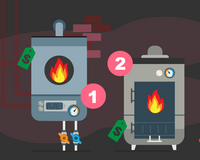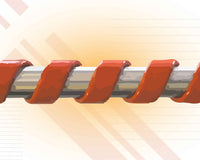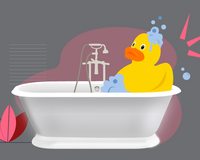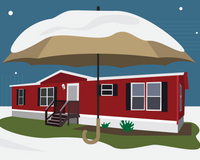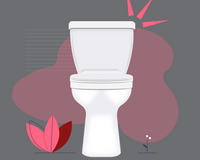Partially because of necessity and partially because of cost, mobile home plumbing systems are not the same as those installed in site-made homes. Nonetheless, the most common mobile home plumbing problems — leaks, drips, clogs, low pressure, etc. — should sound familiar to just about anyone.
Due to the way mobile home plumbing is set up, however, these problems may manifest and need to be addressed differently.
How is mobile home plumbing set up?
Like all plumbing systems, mobile home plumbing has three major components — supply lines (incoming), drain lines (outgoing), and ventilation (to maintain pressure equilibrium).
Supply lines
Supply lines feed water from a municipal source or well into the mobile home. The main supply line splits off to the water heater and parallel hot and cold lines that connect up with plumbing fixtures such as faucets, mobile home kitchen sinks, and tubs.
Drain lines
Drain lines are designed to carry wastewater out of the mobile home safely and efficiently using a combination of gravity, traps, and ventilation (its complementary major component). Pressure flushes waste along the proper path. Grading (slanting) drain lines by ¼ to ½ inch per foot assists with the outflow.
Ventilation
Ventilation pipes help infuse fresh air into plumbing fixtures, helping them move water through drainage. Plumbing air vents help funnel unpleasant odors and sewer gases out of the home.
How does this differ from site-built homes?
Unlike plumbing in site-built homes, however, supply and rain lines do not run through walls — instead, they come up through the floor. This dictates where certain plumbing fixtures can be located. It also tends to lack clean-outs — accessible areas within the drainage (sewage) line that can be opened up to remove blockages or clogs.
As far as materials go, plastics such as PVC (polyvinyl chloride), CPVC (chlorinated polyvinyl chloride), PEX, and PolyPipe are the standard for mobile home plumbing — although it’s not unusual to see copper piping used for supply lines. The construction and durability of modern plumbing systems are much better than it was in the past, but bear in mind that the national HUD codes it has to meet are not quite as stringent as the local codes that site-built homes are beholden to.
Common mobile home plumbing problems
Frozen pipes
Uninsulated piping — especially uninsulated copper piping — can be susceptible to freezing up during cold spells, which is why it’s vital to winterize your mobile home in the fall.
Make sure skirting (around the bottom perimeter between trailer floor and the ground) and underbelly (sheeting material underneath the insulation and floor boards) is fully intact — this will help shield pipes from drafts and cold air.
An even more direct way of preventing frozen pipes is mobile home heat tape.
Leaks
As mobile homes settle and piping ages, leaks can start to become a problem.
If leaks are the result of a loose joint or connection, the fix can be as simple as tightening the offending joint and/or applying rubber sheeting, leak tape or joint filler. In the event of cracked piping, you’re way better off replacing entirely.
Leaky or drippy faucets or taps again can often be blamed on loose or damaged parts. Taking the tap apart and tightening or replacing these parts is the solution.
Clogs
Clogs in mobile homes can be tricky to locate and correct, but when dirty water starts pooling up and strange odors build, it’s obvious that they’re there. Clogs are often attributable to either a stoppage issue or a ventilation issue
A snake tool is your best friend for pushing or pulling clogs through. Hand snakes are very affordable for the average homeowner and can take care of most minor stoppages, while commercial snakes will take care of just about anything.
Backflow from a toilet into a bathtub can be corrected with a tool called a closet auger, a rod-and-cable device that drills the clog away.
Low pressure
The first thing you want to ask is whether the low water pressure is affecting the whole house or is localized to one fixture. If it’s more widespread, it could be due to a clog or ventilation issue. If it’s confined to one fixture, then it may be a matter of cleaning or replacing an aerator, valve, filter, or screen.
Plumbing maintenance tips
The best way to counteract mobile home plumbing problems is to prevent them in the first place. Clean pipes once a month with a non-corrosive drain cleaner or little baking soda with hot water. Use drain strainers and lint catchers to prevent buildup and clogs.
In the kitchen, avoid dumping grease down the drain and do not become overly reliant on your garbage disposal. In the bathroom, try not to flush anything but waste and toilet paper down the toilet.
Plumbing supplies from Star Mobile Supply
No matter how careful you are, plumbing problems happen. When they do, Star Mobile Home Supply offers a variety of replacement water line connectors, stops, and valves to get your system flowing at peak efficiency.


